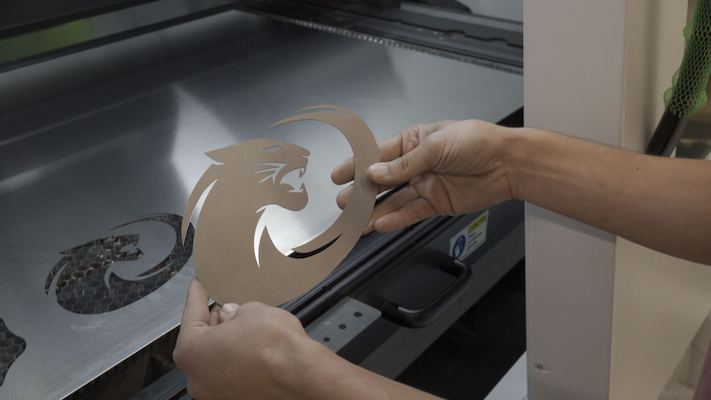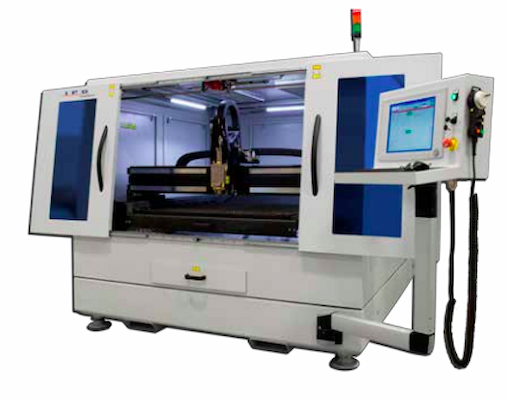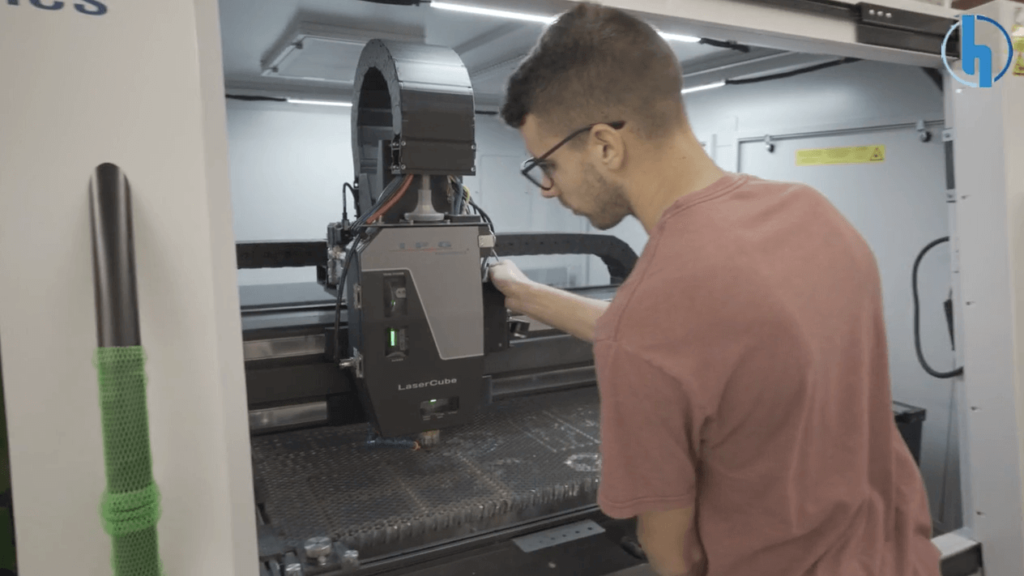Are you designing and manufacturing a metal nameplate for your business?
Struggling to find a fabricator who can cut your intricate design, without long lead times?
When it comes to manufacturing your nameplate, it all comes down to the machine that’s cutting the material.
But which machine is the best one to produce precise cuts quickly?
Introducing: laser cutting.
So, what is laser cutting, and what are its benefits?
In this article, we will explain:
- The three different types of laser cutters
- 5 benefits of laser cutting
- IPG’s Photonics’ LaserCube
- Where you can get the best metal fabrication
Let’s dive in!
What Is Laser Cutting?
First, let’s begin by explaining that laser stands for light amplification by stimulated emission of radiation.
Laser cutting is the process of using a laser to cut or engrave materials. It is often used for thicker metals that normal machines cannot cut through.
A laser cutter is a computer numerical control, or CNC, machine. This means it is controlled via a computer – not manually by a person. Using design software, the manufacturer can put in a precise design, and the cutter will automatically create it.
Types of Laser Cutters
There are three types of laser cutters:
- CO2
- Neodymium
- Fiber
But what are their differences? Keep reading to find out.
What Is CO2 Laser Cutting?
This laser is created through electrically stimulated gas, mostly carbon dioxide. It is not as strong as the other cutters, so it is best for softer materials.
What Is Neodymium Laser Cutting?
There is neodymium (Nd) and neodymium yttrium-aluminum-garnet (Nd:YAG) formed with neodymium-doped crystals. Nd cutting is typically used for high-energy and low-repetition boring while Nd:YAG is best used for high-power boring.
It has a smaller wavelength than CO2 lasers. This means it has a higher intensity, so it can cut through thicker materials. But because of the high intensity, its parts wear faster.
What Is Fiber Optic Laser Cutting?
This laser is made up of what is called a “seed laser.” This process uses a high-power laser that is directed through optics as well as CNC.
The laser is moved with a motion control system to cut a pattern into the metal, leaving high-quality edges. Additionally, you can vary its focal length, allowing you to cut different layers and varying depths.
While it works at the same wavelength as Nd lasers, it requires less maintenance due to its non-moving parts.
How Does Fiber Optic Laser Cutting Work?
So, where does the laser come from? It is created when lasing materials are formed by electrical discharges in a confined space.
With a partial mirror, the lasing material is reflected and amplified until enough energy is created to make a stream of coherent monochromatic light. The light is directed by fiber optics through a lens onto the work area.
As it hits the material, it melts a micro pit and creates an anti-shock wave.
5 Benefits of Laser Cutting
There are several benefits to using all laser cutting systems, but we recommend fiber optic laser cutters. Here are 5 advantages to using laser cutters for your fabrication projects.
1. Quick Turnaround
Unlike most cutting processes, laser cutting is not messy and requires less cleanup or post-cutting sanding. This means you do not have to have as much downtime between sets.
Additionally, it is more efficient and cuts at a faster rate than manual cutting, or even other laser cutters. This means you can produce larger quantities in a shorter amount of time.
2. Affordability
From initial purchase price to lifetime costs, fiber optics saves a lot of money for manufacturers and in turn gives customers, like you, a cheaper price. Using fiber optic laser cutting reduces maintenance by about 50% because its parts are reliable with fewer moving parts and mirrors.
Not only that, but it produces less material waste, because the kerf width is very thin, and it consumes less energy, which translates to lower costs.
3. Intricate Design Capability
Another benefit of fiber optic lasers is that it produces more precise cuts because the light beam does not wear down. You also consistently get high-quality results because there is no chance of human error.

Using fiber optic laser cutting, you can create complex designs on smaller parts. This high level of accuracy makes it perfect for creating medical devices.
4. Works On Any material
Laser cutting is perfect for any application; it is not limited to any material because it can cut material up to .86” thick. It works on plastic, wood, paper, cardboard, or metal, including stainless steel.
It also has the ability to cut materials that are reflective without the worry of back reflections causing damage to the machine. This means you can cut copper, brass, and aluminum.
5. Energy Efficient
Laser cutters are generally more energy-intensive than other cutting methods, but Fiber-optic lasers are far more efficient than CO2. It uses about one-third the amount of energy and a quarter of the power of other lasers.
Fiber optic lasers require no gases, eliminating toxic emissions.
The Best Fiber Optic Cutter, IPG Photonics’ LaserCube
IPG Photonics is a leader in fiber lasers, developing lasers since 1990.
This flatbed fiber laser cutter offers 2 kW average power and 4 kW max peak power. This machine is very reliable and has low operating and part-processing costs.

It uses high-force linear motors and has the stability and acceleration perfect for cutting small parts precisely.
Get High-Quality Metal Fabrication With Hallmark Nameplate
Tired of long lead times and sloppy cuts? Need a machine strong enough to cut through stainless steel or thick metal? Give Hallmark Nameplate a call.
Get high-quality custom metal fabrication for any application at a fraction of the time and cost of other manufacturers.
We use only the best technology, which is why we’ve invested in IPG’s Fiber Optic LaserCube. We can custom fabricate any intricate design with precise cuts for our customers every time.
Ready to get started? Visit our website or call 352-383-8142 to request a free quote.




